Hello, welcome to the official website of Yunnan Shangri-La Balagezong Tourism Development Co., Ltd!

02
2015
-
12
Tibetan Ba Ye
作者:
xianzi, also known as "xianzi", "ye", "ba ye", is a kind of huqin unique to tibetan, generally played by men. Xianzi dance, also known as "Xianzi", is a comprehensive Tibetan song and dance art that integrates song, dance and music with the accompaniment of the instrument Xianzi. Xianzi dance is distributed in eastern Tibet and Tibetan-inhabited areas such as Yunnan, Sichuan and Qinghai. It is an indispensable self-entertaining song and dance in the lives of Tibetan people.
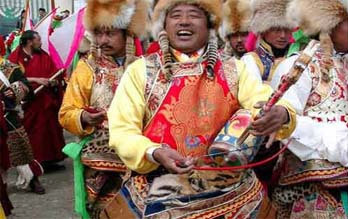
There is no fixed place for string dance, but it can become a dance floor in a flat place, such as courtyard dam, roof and room. All lovers, men, women and children can set foot in the dance floor. During festivals, happy events or major gatherings, people gather together happily. Men pull strings and dance long sleeves. Each row forms a circle in half. One leader sings, while the other repeats and exchanges, forming a unique duet of the same words. Its words, songs and dances are more beautiful and have a wide range of mass character.
distinctive features
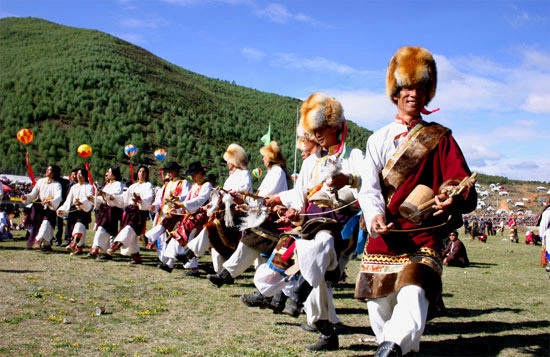
During the performance, the men pulled the strings and the women danced the sleeves. With the changes in the rhythm of the strings, the singing and dancing styles varied. Most of the lyrics of the string for the welcome, meet, praise, affection, farewell, wish the content; a variety of tunes, rich lyrics, dance changeable. During the dance, the men's and women's dance teams each formed a half circle, sometimes gathered together, sometimes evacuated, and sang and danced. The men's dancing posture focuses on dancing boots and stamping their feet, showing the beauty of boldness and ruggedness. Women highlight the beauty of long sleeves, softness and stretch.
The content of Xianzi dance generally includes three aspects: first, the welcome dance and the meeting dance, which welcome and thank each other and praise each other; The second is to respect the elders and love the hometown. The third is to express the love and pure and sincere friendship between young men and women. The content includes love songs and dances of meeting, talking about love, parting and wishing. The melody is lively and enthusiastic, and the dance is relaxed and lyrical.
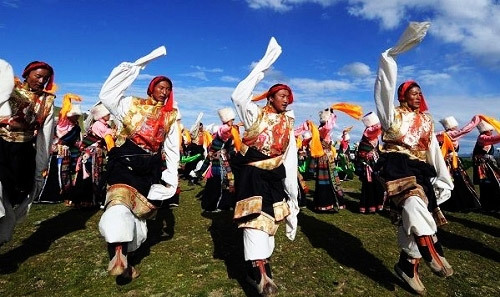
The string dance is full of songs and dances, with graceful dance, both rigid and soft, fast and smooth melody, and bright and cheerful rhythm. Most of its tunes are high-pitched, loud and clear, bold and colorful. The structure of music is generally two phrases, and there are many four phrases. One tune, multiple lyrics, repeated singing. Start the dance slowly, with the content development and speed up, with rapid rotation of the dance steps into the climax. The song actually has a title, which is equivalent to the title of the Chinese word. Belongs to the harmonic folk song, each tune of the movement dance posture is different, sometimes leisurely, sometimes lively and boiling, sometimes just like colorful bridge. First for carols, friendship songs, and then for antiphonal songs, men and women compete with each other to win by skill. If the antiphonal songs persist for a long time, or there are conflicts caused by mutual sarcasm and attacks, the lead dancers will go on stage to lead and persuade them to sing and explain the songs, and the two parties will happily break up.
The basic movements of the female dance partner of the string dancer are a few, including swing steps, double twisting steps, cushion steps, double winding hands, single twisting steps, left and right leisurely legs, forward steps, tossing and turning, forward steps and backward steps. The male dance partner holds the string and dances while singing, and the footsteps are similar to those of the female dance partner. Dancing sleeves is the basic feature of string dance, and three steps and one bend is one of the basic movements in string dance steps.
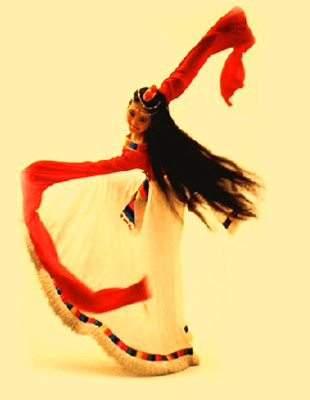
In addition to the fixed lyrics of some ancient songs, the lyrics of the string dance are improvised and the content is wonderful. The structure of the lyrics is mostly in the "association" format of six words and three meals, and also in the "Lu style" grid format of seven words and four meals, eight words (or nine words and ten words) and five meals. Lyrics creation and comparison, Xing, Fu and other methods, the metaphor is vivid, the implication is profound, the expression of emotion is subtle and beautiful, the statement is simple and natural. At present, many artists have given new life to the traditional string dance in the world, and created many string dances that praise the new life. So that the string dance is both gentle and elegant, intriguing characteristics, but also has a bold and free and easy, for the conventional style.
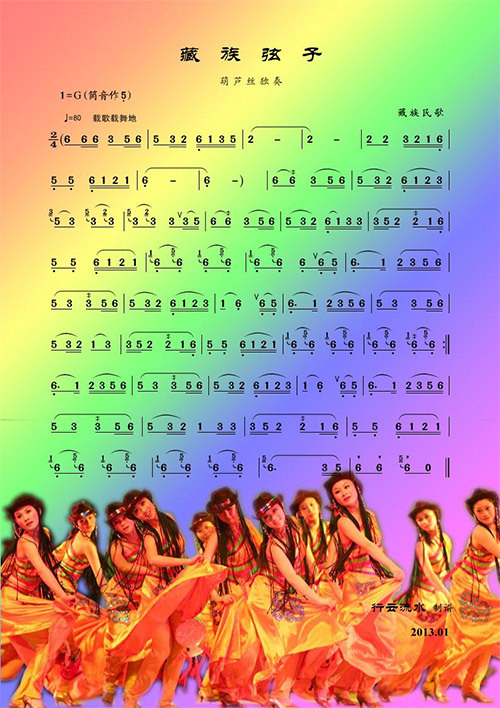
Mangkang County is located in southeastern Tibet, at the junction of the three provinces of Tibet, Sichuan and Yunnan. Xianzi Dance is a folk song and dance in the region. It uses Xianzi as an accompanying instrument. Men and women gather together and dance and sing to the music. The Mangkang Xianzi dance is also called "Han Xie Qiang" in Tibetan, "Han" means Tibetan, "Xie" means song and dance, and "Qiang" means dance. Xianzi called "Biwang", is a local people's own invention of the erhu, in the history books called "Huqin". The string dance is the only local folk song and dance unique to Mangkang. During the festival, people gather in one place and dance with long sleeves behind one or several men who are playing the piano and dancing frequently.
A long history
Mangkang Xianzi Dance has a long history. According to textual research, Mangkang had a history of dancing Xianzi Dance in the Tang Dynasty, but at that time Xianzi Dance was mainly a single singing and a small family-style song and dance. The development of the "Ancient Tea-Horse Road" in the Tang Dynasty injected the vitality of innovation and development into Mangkang Xianzi Dance. In their communication with other nations and surrounding areas, the intelligent Mangkang people constantly absorb the culture of other regions and nations, constantly add color and nourishment, constantly develop and innovate, and then combine with the current songs and dances, accompanied by melodious songs with beautiful dances, and with life as the theme, everyone creates, everyone sings and dances, and everyone processes, the culture and art with unique national and regional characteristics, which has been continuously enriched and developed, is a kind of hobby and entertainment of the masses, and has become a treasure in the long history of Tibetan culture and art, and is known as the "charm of the ancient road of tea horse".
The string dance is a string as a musical instrument, with the music melody, men and women gather to dance. The Tibetan language is called "Han Xie Qiang","Han" means Tibetan, "Xie" means song and dance, and "Qiang" means dance. Xianzi is called "Baiyang", which is an instrument invented by the local people themselves. Erhu is shorter and thicker than erhu in other regions. It is called "Huqin" in history books ".
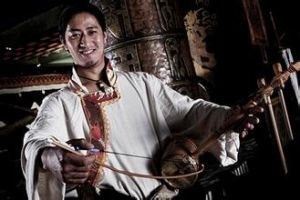
There are no restrictions on the string dance, regardless of the number of people, the size of the venue, or the stage and off the stage. When dancing string, they usually dance in a circle around a bonfire, and when there are many people, they can also be circled. Men and women are separated by half. The man pulls the strings and stands at the head of the row, leading the crowd to dance with his sleeves swept, sometimes rounded, sometimes scattered, and sometimes danced around, singing and dancing. The lyrics are "harmonic" folk songs, which can also be improvised, with men and women singing in different classes and singing one after another to express their inner feelings. The rhythm of the dance is based on the rhythm of the man's music. The rhythm of each song and dance is generally slow first and then fast, starting in a melodious and gentle melody, performing in a smooth and cheerful manner, and ending in a rising and enthusiastic manner.
Mangkang Xianzi
The dancing posture of Mangkang Xianzi is round, wild and smooth, with dragging steps, turning around, shaking sleeves, quivering steps and other movements, with long sleeves flying the most distinctive. The dancers give out bursts of "quivering" with the shaking of the string music, and the dance movements produce "quivering method" accordingly. These movements are mostly characterized by simulating some kind and auspicious animal posture movements, including "peacock sucking water", "rabbit running" and other categories.
The arrangement of the string dance is also orderly, with a dance head and a dance tail. The leader, or "harmonic version", is generally an influential person in the string dance, who can not only sing and dance well, but also compose and choreographer. Each song and dance has its own music, words and dance method, dance day and night can not finish. Because the string dance has too much content, it can also be used as a topic. It is a dance that can't be sung or danced. There is a saying in Mangkang: "It is not the string dance that ends."
The string dance is mostly characterized by simulating some kind and auspicious animal posture movements, such as "Peacock Absorbs Water", "Rabbit Run" and so on. The dance steps are mellow and stretched, with melodious and smooth tunes. The movements of the string dance, such as "dragging", "turning around", "shaking sleeves" and "quivering steps on the hips", especially the long sleeves are very distinctive.
The content of the lyrics of the string dance is very extensive, there are singing labor life, there are depicting the natural scenery, there are pouring out love ...... The string dance not only gives people the enjoyment of music, but also is the essence of a folk language, it is the free-spirited folk poetry, testing the intelligence of the folk game, to give people upward spiritual food, rich flavor of life and profound educational significance.
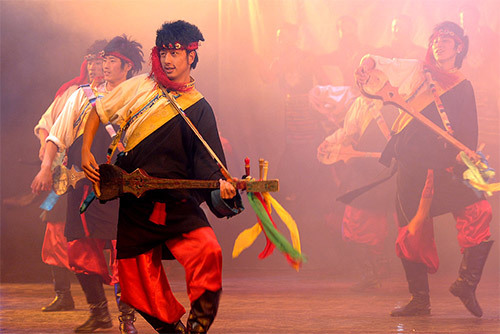
Category resolution
Mangkang Xianzi Dance can be divided into: dignified and stable Yanjing Xianzi Dance (including Upper and Lower Yanjing, Quzika, Muxu, Nine Dragons and other places); natural and elegant Xuzhong Xianzi Dance (including Xuzhong, Gnangxi, Maiba, Kabu and other places); difficult and easy to stretch Sordosi Xianzi Dance (including Sordosi, Julong and other places); free and open song Deng Xianzi dance, etc. According to the region, it is divided into: light, smooth and bright valley xianzi dance; Rugged, simple and vigorous mountain xianzi dance in semi-agricultural and semi-pastoral areas; Simple and solemn pastoral areas, such as mountain xianzi and Guozhuang dance (harmonic Mazhuo), all have distinct local characteristics and their own characteristics.
Yanjing Xianzi dances dignified and steady, showing its own characteristics in the dignified and steady, with the momentum of the Lancang River, the charm of high mountains and flowing water, and the magnificent lyrics, giving people a feeling of pride and ambition and striving for progress. The three-string dance of Quzika is unique in the style of Lancang River and Jiangxi Province, with the charm of the "Ancient Tea Horse Road", the magnificent tone and the rough dance posture, primitive, simple and elegant.
Xu Zhong Xianzi dance chic and elegant, long sleeve stretch, melodious singing, melodious melody, foot drag point, turn around chic, smooth movement. Music and dance steps are closely combined, rich lyrics and melodious songs give people an original feeling.
Good at imitating the Sodosi string dance, the movement is difficult and relaxed, giving people a sense of unrestrained and lively. Long-sleeved brushed, the range of movements is large, the music is happy and cheerful, the footsteps are relaxed, and the body is stretched, highlighting the characteristics of long-sleeved dance. The "Rabbit Happy Run" dance is the representative work of Sodosi's string dance, which expresses the Sodosi people's yearning for freedom, pursuing love, loving life, and praising their hometown.
The free and open, relaxed and cheerful, bright rhythm and warm mood of Qu Deng Xianzi dance show that the people of Qu Deng love nature, yearn for freedom, peace and the pursuit of a better life.
Due to the differences in natural environment, history and culture, Mangkang Xianzi dance has many schools, but its general characteristics are simple, rugged, vigorous, strong and simple. It is integrated with the local natural scenery: blue sky and white clouds, snow mountain grassland, canyon rapids, dangerous shoals and galloping horses, etc., forming Mangkang's unique humanistic landscape.
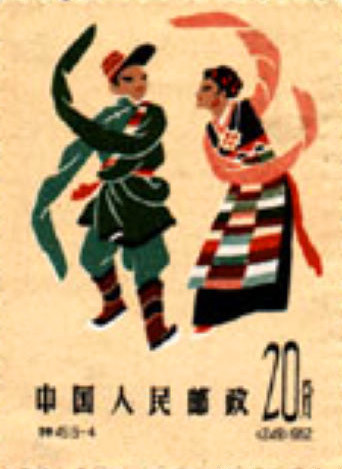
In Mangkang, the string dance has become a popular hobby and entertainment, and has become "a song and dance that everyone can dance and every family is happy". During the festive season, the enthusiastic and active Mangkang people go out one after another, pouring their homes, villages and cities, bringing food and accommodation, to watch and perform day and night, performing their own music and singing and dancing carnival, forming a "sea of songs and dances" and "the world of strings". In farming and pastoral areas, farmers and herdsmen work while singing, and dance around the circle when they rest. Even three people can dance around a campfire for their own joy. String dance has become an indispensable part of people's lives.
Art Treasure
Tibet is known as the "sea of singing and dancing". The Tibetan people are good at singing and dancing, and are known as "a nation that can speak and sing, and can walk and dance." No matter men, women, old or young, they can dance. Mangkang's Xianzi dance is also a wonderful flower among the flowers of Tibetan national culture. Its simple, elegant, fluttering, melodious and cheerful characteristics make people never tire of seeing it. Moreover, Mangkang Xianzi dance reflects its own life, expresses its thoughts and feelings, and shows its unique aesthetic and artistic taste. It is one of the precious cultural heritages inherited and developed by Tibetan culture.
Nowadays, Mangkang Xianzi dance has become an important way of entertainment for the broad masses of Tibetan people. During the festive season, the 16 townships (towns) of Mangkang carry out rich and colorful literary and artistic activities, mainly Xianzi dance. These activities enrich and invigorate the spiritual and cultural life of the masses, improve the cultural quality of the masses, and enhance their love for the motherland and hometown. Mangkang Xianzi dance has a long history, ancient magic, unique form, strong national temperament, rich plateau characteristics, more genres, complete performance system, its song and dance tradition is precious.
Batang Xianzi
"xianzi" is called "ga xie" in tibetan, also known as "xie", "ye", "ba ye" and so on, which means circle dance and belongs to one of the three major types of tibetan dance. It is popular in eastern Tibet and Tibetan areas in Yunnan, Sichuan and Qinghai, with Sichuan Batang Xianzi being the most famous. Batang County is located in the junction of the three provinces (regions) of Sichuan, Yunnan and Tibet. It belonged to the White Wolf Kingdom in ancient times. The "White Wolf Song" of the White Wolf Kingdom is a kind of ceremonial song and dance that integrates poetry, music and dance. Batang Xianzi is the legacy of its later generations. After more than a thousand years of development, it has become a folk song and dance loved by the Tibetan people.
Batang Xianzi is a beautiful and lyrical Tibetan dance with the characteristics of "long-sleeved good dance". During the performance, several men play the lead dance in front of the team with the stringed instrument "Biwang" (huqin). The rest of the dancers sang and danced with them. In Batang, every festival, men and women gather to sing and dance. Generally, the male gymnastics "Bai Wang" (Niujiao Hu) stands at the head of the row, pulls up the huqin and leads the crowd to dance with his sleeves brushed. sometimes it is rounded, sometimes it is scattered, sometimes it is around and dances, singing and dancing, and the lyrics are "harmonic" folk songs. It can also improvise male singing and female singing to express the inner feelings. "Three steps, one lift, one step, one lean" is the basic rhythm characteristic of Batang string dance. Its movements of winding, supporting, lifting and covering with chest, trembling knees and long sleeves form different general regional dance characteristics. During the festive season, people gather in the "Linka" (glade in the forest) or the dam to dance the string dance, regardless of the number of men and women. Xianzi music is generally divided into three parts: prelude, interlude and epilogue. The music is soft and rigid, beautiful and lyrical, and the rhythm is rich in dance.
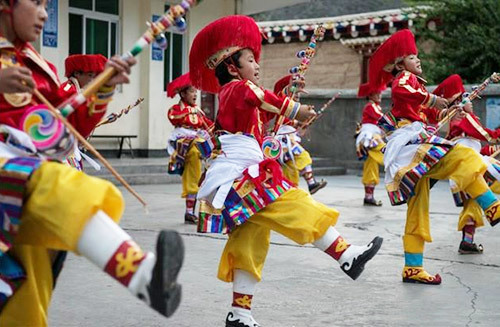
Batang Xianzi is the crystallization of the wisdom of the people of Batang. Batang Xianzi Dance accumulates a thick national culture and reflects a strong national customs. Its academic value and artistic value are very high. In May 2000, the Ministry of Culture officially named Batang County as "the hometown of Chinese folk art". With thousands of songs, Batang Xianzi has become the biggest treasure of Tibetan folk music. It is the best preserved "living fossil" of Tibetan music. Its music and lyrics have penetrated into other Tibetan literature and art. The protection of Batang Xianzi is of great significance for the protection of Tibetan song and dance art and the study of Tibetan culture.
The state attaches great importance to the protection of intangible cultural heritage. On May 20, 2006, Xianzi Dance was approved by the State Council to be included in the first batch of national intangible cultural heritage lists.
下一条
下一条
最新动态
2022-08-23
The current outbreak, the responsibility is on the shoulder, Balagzon in action!
Since the outbreak of the epidemic in Tibet on August 7, 2022, a large number of tourists from Tibet to Yunnan have entered Shangri-La from National Highway 214. The People's Government of Diqing Prefecture has issued a series of relevant policies and measures and actively responded. Medical staff, police and other front-line personnel stick to the front line, have been involved in the "war of resistance" of the epidemic without gunpowder smoke, and jointly participate in dealing with a major public health security incident faced by mankind.



